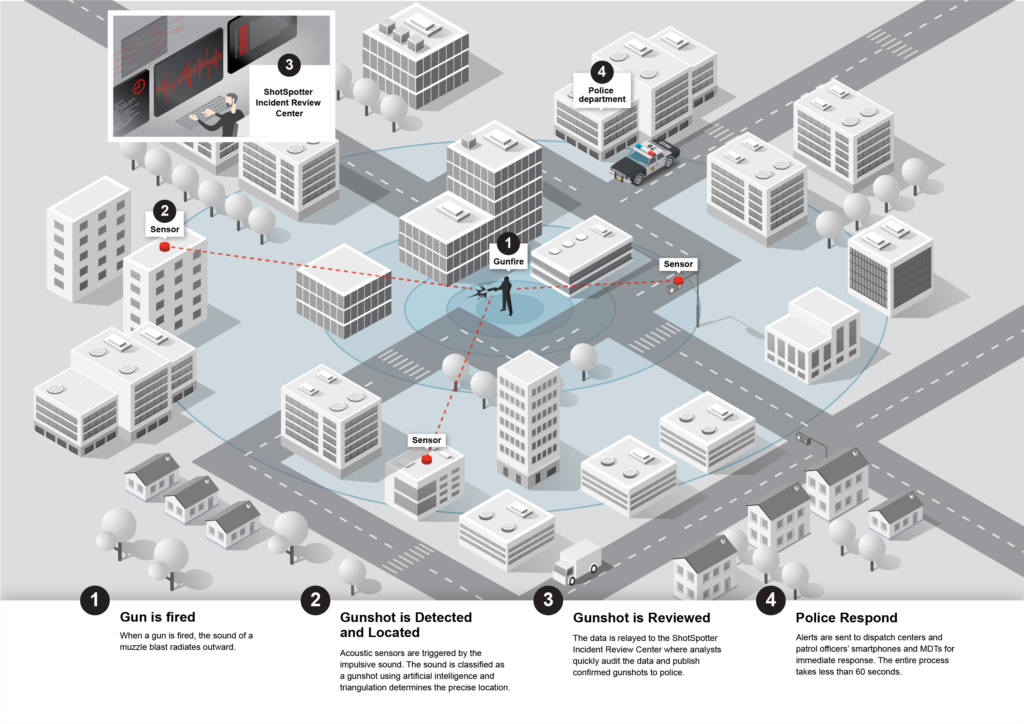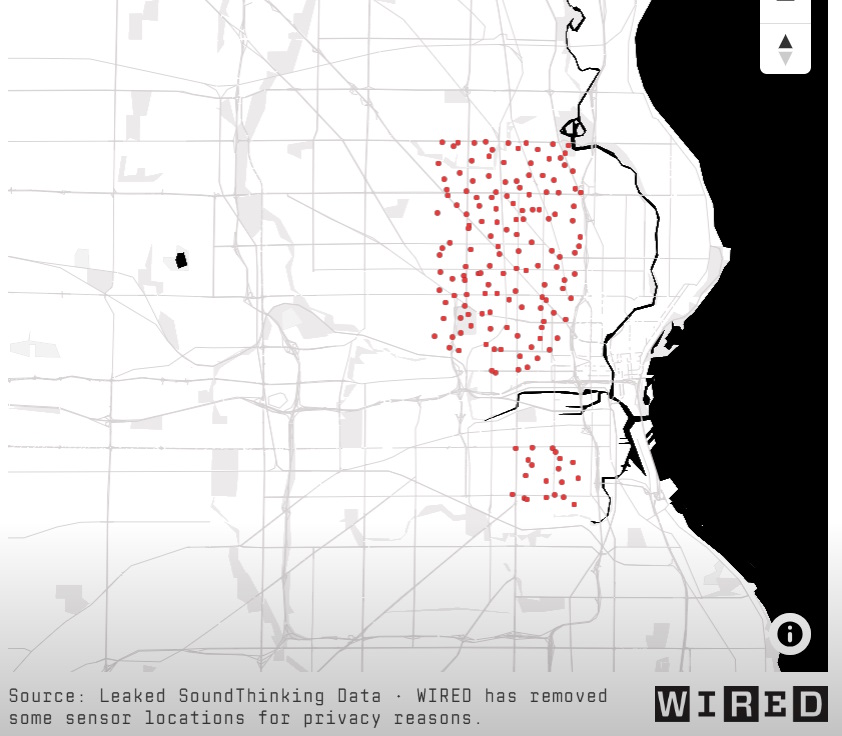See Where Milwaukee’s Secret ShotSpotter Sensors Are
Data leak reveals what MPD and company have attempted to keep private.
You can now see exactly where in Milwaukee gunshot detection sensors are located due to a nationwide leak of ShotSpotter equipment deployments.
SoundThinking’s ShotSpotter system attempts to triangulate gunshots using a network of mounted microphones. The system captures audio data, sends it to a company review center and, if accepted as a gunshot, inserts a call for service with an estimated location.
When it works as planned, the system yields near real-time data about gunfire that allows officers to get to the scene faster, while also producing an audio recording and historical data that can be mined for trends. It avoids the need to hope a citizen reports gunfire, which Milwaukee Police Department (MPD) officials previously estimated only happens 14% of the time.
In Milwaukee, which first instituted the system in 2010 and expanded it in the ensuing decade to 11 square miles, the network has been known to only cover a portion of the city. But exactly what portions of the city were covered was unclear, until now.
Across the country, critics of the system have raised privacy concerns, questioned its effectiveness and argued that it leads to over-policing of neighborhoods predominantly occupied by lower-income, minority residents.
Since its deployment, MPD and Sound Thinking have declined requests to provide the locations of the sensors. But a leaked document, provided to technology publication WIRED, reveals the sensor locations in 84 cities.
System Map
Article continues below
A southside cluster is bounded roughly by W. Greenfield Avenue, W. Lincoln Avenue, S. 6th Street and S. 27th Street. A much larger northside cluster is bounded by W. Silver Spring Drive, W. Wisconsin Avenue, Interstate 43 and N. 51st Street.
According to an MPD-maintained crime map, the ShotSpotter area covers the areas that are experiencing the greatest number of homicides and non-fatal shootings. But it doesn’t include portions of the sprawling northwest side that have substantial shooting rates.
Police Chief Jeffrey Norman is a believer in the system. For the past two summers, MPD undertook “Operation Summer Guardian,” which was centered on the deployment of a team of officers to respond to calls for service generated by the system. In 2023 the operation was expanded to also respond to shootings reported by other means.
“Understand that this is not about being an occupational force,” said Norman at a July 2023 press conference announcing safety effort. “As a department, we are information-driven.”
Mayor Cavalier Johnson has also supported the system. At a May 2023 Rotary Club of Milwaukee speech, Johnson played audio clips of several guns being rapidly discharged in separate incidents near S. 13th and W. Burnham streets on May 6. “To me, that sounds like a warzone,” said Johnson. “It’s something that has got to stop.”
There is plenty of information coming from the system. MPD told Urban Milwaukee that the system generated 14,684 activations last year. ShotSpotter calls for service are the third most common service request, behind “trouble with subject” and “welfare citizen,” and represent 5% of all service requests.
In 2022, the Wisconsin Supreme Court upheld the use of the system to generate probable cause to search an individual located nearby. MPD also augments the ShotSpotter system with pole cameras, which can be used for remote surveillance in targeted areas.
But, like critics of SpotSpotter have raised, the system covers the overwhelmingly Black near north side and the overwhelmingly Hispanic near south side. None of the sensors are placed in majority-white neighborhoods. All of the sensors are placed in neighborhoods where average incomes are below the federal poverty line.
That’s consistent with how other cities have deployed ShotSpotter.
“An analysis of sensor distribution in US cities in the leaked data set found that, in aggregate, nearly 70 percent of people who live in a neighborhood with at least one SoundThinking sensor identified in the ACS data as either Black or Latine. Nearly three-quarters of these neighborhoods are majority nonwhite, and the average household earns a little more than $50,000 a year,” says the WIRED article by Dhruv Mehrotra and Joey Scott.
According to the leak, there are 25,580 sensors across the country.
MPD confirmed to Urban Milwaukee that the department selects the area it would like monitored and that SoundThinking determines the exact sensor location.
On a national level, the civil-liberties nonprofit Electronic Privacy Information Center asked the U.S. Department of Justice to investigate whether cities are committing a Civil Rights Act violation in how they deploy the technology.
The issue has also become a polarizing political issue in Chicago, with Mayor Brandon Johnson pledging on the campaign trail to terminate SoundThinking’s contract. He’s now effectively done so, but with an unusual twist. News broke Thursday that the Windy City will pay $8.6 million for a nine-month extension to keep its large system operating through the summer and Democratic National Convention. The amount exceeds the cost to operate the system for all of 2023. And the Chicago mayor’s handpicked police chief continues to back the system.
Milwaukee is the only Wisconsin city that utilizes the technology, with Beloit scuttling its system in 2012. From 2010 through 2022, Milwaukee spent $3.7 million on the system. Portions of the cost were offset by a series of state grants. During that time period, the city’s homicide rate has fluctuated dramatically.
MPD’s 2023 budget presentation says SoundThinking has a $5.25 million contract with the city that lasts through March 2026. The Comptroller’s Open Checkbook website shows the company was paid $514,964 in 2023.
If you think stories like this are important, become a member of Urban Milwaukee and help support real, independent journalism. Plus you get some cool added benefits.
























Any news or follow up reporting on the effectiveness of the technology from the city or MPD would be great.
so, we can have this system but not red light cameras. yesterday, i saw 2 drivers run completely red lights a bicyclist run a red and go up farwell which is a one-way street going south and a motorcyclist not outrunning a yellow. this all happened on the east side in one day. no police in evidence and thank the universe, no accidents.
So it’s leak and you are publishing it? Why?
I agree with Wardt01. What is the effectiveness of the system as used here, and how does that compare with gunshots fired with accompanying consequences in OTHER parts of the city where this system is not in use, using MPD reports of gunshots reported? Can these sensors be mobile, and moved to different locations at different times where increased crime may occur?
Tornado75’s question about red light cameras–previous stories have indicated that the State of Wisconsin prohibits their use. So that’s why.
And KFG wants to know why publicizing a leak? That is the role of media such as URBAN MKE to keep citizens aware of what is going on. It’s our tax money being used for such things, and don’t you think we all should be critically aware of the use of tax money and to assess efficacy?!
WOW image that! Nation wide use of the technology happens where shots are frequently happening! Near instant communication of the exact location of shots fired verses piecing together call for service information. If there was an endless pot of money, you could put them all over the city, but it is good government to spend limited resources where you have a documented problem with reports of gun shots.
And yes, the state legislature passed legislation prohibiting use of cameras for traffic enforcement unless the driver can be identified and the ticket issued to that person. Most states allow the citation, like a parking ticket, to be issued to the owner of the vehicle.
Rational allocation of scarce resources is a fundamental principle of economics. They are placed where shootings are prevalent. Do shootings take place outside these areas? Sure. Daily, or multiple times a day? No. Are there false positives? Sometimes. But is it generally accurate? Yes. There was no PD response to a firecracker which may or may not have been tossed on the roof of the firehouse near the detector. At a fatal shooting we (FD) responded to we were helping the PD locate shell casings. Found 6 of 7. An officer phoned the ShotSpotter operator who told her, “7 large caliber shots moving NNE at 6 miles an hour” which fit the scene; shooters drove up on him, dropped him, then administered a coup de grace leaving one slug on the side walk. PD later found the final casing in the grass with a metal detector.